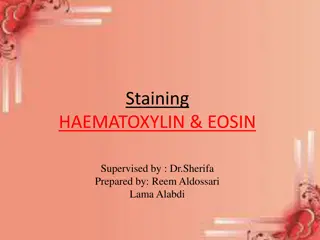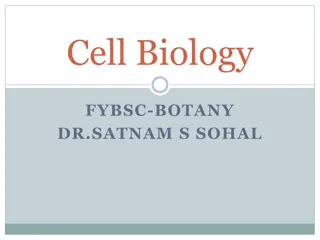Understanding Histology and Cell Structure Fundamentals
Delve into the intriguing world of histology and cell structure, exploring the composition of cells, the functions of various components like the nucleus and cytoplasm, and the significance of organelles. Discover how histology is studied, the types of microscopes used, and the vital role of the cell as the fundamental unit of living tissues. Uncover the intricate details of the nucleus, including its formation, shapes, and essential functions in cellular vitality and genetic information. Gain insights into the nuclear envelope, nucleolus, and nucleoplasm, all crucial elements for cell function and genetic expression.
Download Presentation

Please find below an Image/Link to download the presentation.
The content on the website is provided AS IS for your information and personal use only. It may not be sold, licensed, or shared on other websites without obtaining consent from the author. Download presentation by click this link. If you encounter any issues during the download, it is possible that the publisher has removed the file from their server.
E N D
Presentation Transcript
Introduction To Histology And Cell Structure
Content & Objectives : In this lectures you are expected to learn : What is Histology and how it is studied ? Composition of the cell : Light microscopic (L/M) & Electron microscopic (E/M) Function of each component : Nucleus Cytoplasm Organelles : membranous and non-membranous. inclusions
Introduction Histology is the microscopic study of normal tissues. Types of Microscopes : Light microscope (colored) Electron microscope ( black & white) Thin sections are cut and mounted on glass slides, sections are then stained with hematoxylin (H) and eosin (E). Nucleus is always blue (basophilic). Cytoplasm may be red (acidophilic) or blue (basophilic).
THE CELL Is the structural & functional unit of all living tissues. Cell have different shapes & sizes . The cell is made of : Nucleus. Cytoplasm . Body System Organ Tissue Cell
Nucleus (E/M) Formed of : Chromatin . Nucleolus . Nucleoplasm . nuclear envelope Functions: it is essential for vitality and division of the cell. It is the site of storage of genetic information. It is the site of formation of the three types of RNA .
Nucleus Shapes of Nuclei : Appearance of Nuclei: (1) Dark Nucleus (Deeply- stained nucleus) Deeply basophilic Nucleus. (2) Vesicular (open face) Nucleus.
Definition Function Nuclear Envelope Functions: (pores) A double membrane with many pores. a) Outer membrane. b) Inner membrane. c) Nuclear pores: provide communication between nucleus and cytoplasm. Functions: Carries genetic information. Directs protein synthesis. Formed of DNA. 2 Forms: Euchromatin: extended active chromatin (pale= electron-lucent areas). Heterochromatin: condensed inactive chromatin (dark = electron dense areas). Chromatin
Definition Function Function: formation of ribosomal RNA (rRNA), which is responsible for protein synthesis in the cytoplasm. E/M: It is mostly dark mass (electron-dense) not surrounded by a membrane. Usually one. L/M: It is a spherical dark basophilic mass. NUCLEOLUS NUCLEOPLASM Function: It is a clear fluid medium in which all the contents of the nucleus are embedded. Provides a medium for movement of 3 types of RNA (ribosomal, messenger and transfer RNA) from the nucleus to the cytoplasm.
SEX CHROMATINS (Barr Body) A dark stained mass of chromatin, usually adherent to the inner aspect of the nuclear envelope of female somatic cells e.g. Buccalepithelial cells. A drumstick mass protruding from the nucleus of neutrophils. Represents one of the two X chromosomes which is inactive (condensed) in normal female . Seen in normal female cells. Absent in females with Turner s syndrome XO. Seen in males with Klinefelter s syndrome XXY.
Cytoplasm is formed of ORGANELLES: They are specialized structures, ESSENTIAL for vital processes of the cell. INCLUSIONS: They are not essential for vitality of cells. may be present or absent. Examples are lipids, glycogen and pigments like melanin & lipofuscin.
CYTOPLASMIC ORGANELLES Membranous: 1. Cell membrane. 2. Mitochondria. 3. Endoplasmic reticulum (rough & smooth). 4. Golgi apparatus. 5. Lysosomes. 6. Secretory vesicles. filaments & microtubules). Non-membranous: 1. Ribosomes. 2. Centrioles. 3. Cilia & Flagella. 4. Filaments: Actin, Myosin & Intermediate filaments. 5. Cytoskeleton (actin, intermediate
Cell Membrane Chemical Structure: 1- Phospholipid molecules: arranged in 2 layers. 2- Protein molecules: a) Peripheral protein b) Integral protein 3- Carbohydrate molecules: attached to either proteins or lipids (glycoproteins and glycolipids), forming the surface or cell coat. (Glycocalyx): a) Protection of the cell. b) Cell recognition and adhesion. IS: Specializations: Cilia: Long motile hair-like structures surrounded by cell membrane. Their core is formed of microtubules. Microvilli (Brush border): Cylindrical cytoplasmic projections of apical surface to increase surface area. Their core contains actin filaments. Intercellular Junctions: Occluding (Tight) Junction: seals the intercellular space. Adherening Junction: fixes adjacent cells together: Zonula Adhering Junction. Desmosome (Macula Adherening Junction). Gap junction: Allow free communication between the cells. A very thin membrane that surrounds the cell. LM: Not visible. EM: appears as 2 dark lines (electron dense), separated by a light one (electron-lucent). (trilaminar appearance). Function: selective barrier.
Mitochondria Each mitochondrion is rod-shaped . The wall is composed of 2 membranes. The outer is smooth, the inner is folded to form cristae. The cavity is filled with mitochondrial matrix, which contains enzymes. Also contains its own DNA. Functions: 1. Generation of ATP which is the source of energy for the cell. They are called the power-house of the cell. 2. They can form their ownproteins and undergo self replication.
Endoplasmic Reticulum (ER) It is a system of communicating membranous tubules, vesicles, and flattened vesicles (cisternae). There are 2 types: Rough (rER). Smooth (sER).
Rough Endoplasmic Reticulum Smooth Endoplasmic Reticulum Membranous sheets of flattened tubules & vesicles with ribosomes on the surface. Functions: 1. Synthesis of proteins by ribosomes on its outer surface. 2. Transfer vesicles transfer the formed protein to Golgi. Membranous tubules and vesicles, with no ribosomes on the surface. Functions: 1. Synthesis of lipids & cholesterol. 2. Synthesis of steroid hormones, e.g. cortisone. 3. Helps musclecontraction, by acting as a calcium pump. 4. Detoxification of drugs & toxins.
Golgi Apparatus The secretory apparatus of the cell. Consists of stacked saucer-shaped flattened vesicles. Each vesicle has two faces: Convex (forming) face, receives transfer vesicles. Concave (mature) face, forms secretory vesicles. Functions: 1.Sorting, modification & packaging of proteins. 2.Secretory vesicles formation. 3.Formation of lysosomes.
Lysosomes The digestive apparatus of the cell. E/M: Spherical membranous vesicles. Contain hydrolytic enzymes. Originate from mature surface of the Golgi apparatus, while their hydrolytic enzymes are formed in the rough endoplasmic reticulum. Function: intracellular digestion of ingested material or old organelles.
Ribosomes LM: Basophilic cytoplasm is due to numerous ribosomes Consist of ribosomal RNA (rRNA), combined with proteins. . EM:Formed of 2 subunits. Free in the cytoplasm (may form polyribosomes) or attached to rER. Formed in the nucleolus. Function: Protein synthesis
Centrioles Microtubules-Containing Organelles 1. Centrioles: 2. Cilia: Hair-like striations on the free surface of some cells. Basal body is similar to centriole. Shaft is formed of 9 doublets and 2 central singlets of microtubules, i.e. 20 microtubules. Function: movement of particles or fluids on the free surface of the cell in one direction. 3. Flagella: Longer and larger than cilia. Form the tails of sperms. Function: important for movement of the sperms. 2 cylinders, perpendicular to each other. Wall is made of 9 triplets of microtubules, i.e. 27 microtubules. Functions: 1- Essential for cell division. 2- Formation of cilia and flagella.
Clinical application Immotile cilia syndrome: Disorder that causes infertility in male and chronic respiratory tract infection in both sexes. is caused by immobility of cilia and flagella induced by deficiency of dynein. Dynein protein is responsible for movements of cilia and flagella.
Cytoskeleton It is the structural skeleton of the cell. Functions: Maintains shape of the cell. Helps transport of material within the cell. Consists of: Microfilaments (actin). Intermediate filaments, e.g. Keratin. Microtubules.
References: Cell organelles https://youtu.be/URUJD5NEXC8 Cell junctions : 1. https://www.youtube.com/watch?v=YwpDA4drrn8&feature=share 2.https://youtu.be/pVWQm-GYK_Y Centrioles , cilia and flagella https://youtu.be/5D5Jt7NZB8I Euchromatin and Heterochromatin https://youtu.be/5D5Jt7NZB8I Microvilli https://youtu.be/hPyn-Gym5XE
THANK YOU ! Some people dream of success while others wake up and work hard at it Histology Team Members: Rana Barasain Reema AlBarrak Shahad AL Anzan Doaa Walid Abdulatif Ghadah Al Muhanna Amal Al Qarni Wateen Al Hamoud Weam Babaier Ahmed Badahdah Mutasem Alhasani Nassir Abodjain Nawaf Aldarweesh Histology Team Leaders: Reema Sultan Al-Otaibi Faisal AL-Rabaii Contact us at : HistologyTeam436@gmail.com























